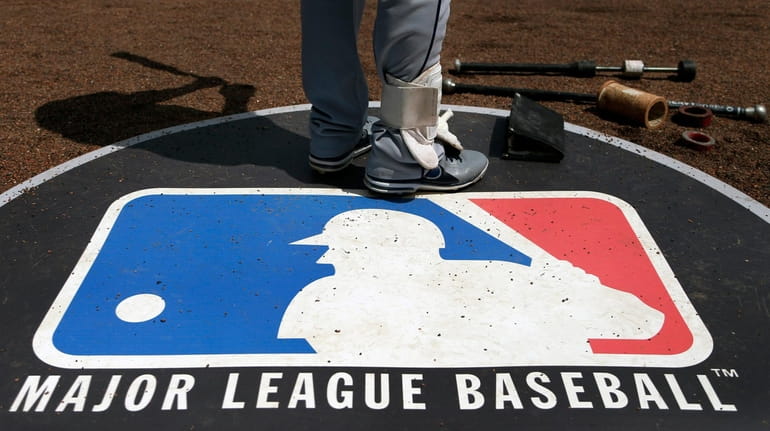MLB's 60-game season may still prove too much to handle

In this April 24, 2013, file photo, Cleveland Indians second baseman Jason Kipnis stands on the Major League Baseball logo that serves as the on deck circle. Credit: AP/Charles Rex Arbogast
During a typical baseball season, 60 games is nothing.
It’s enough for a streaky spring. Or a midsummer slump.
This year, however, 60 games is everything. And that’s the number we finally arrived at Tuesday when the players informed commissioner Rob Manfred of their intention to report by July 1 for spring training as well as cooperate on the ever-evolving health and safety protocols.
“All remaining issues have been resolved,” the Players Association said Tuesday night in a statement, “and players are reporting to training camps.”
Getting to this point was excruciating. The ugly exchanges between the owners and players, performed on the public stage, made for a cringe-worthy five weeks. But those labor pains were merely the necessary evil to get baseball back.
The real challenge will be keeping baseball on the field for those 60 games, followed by a month of playoffs. Almost on cue, within hours of the season becoming official, the Denver Post reported that three Rockies had tested positive for coronavirus, including four-time All-Star Charlie Blackmon, after working out together at Coors Field last week.
With all due respect to the union, there are plenty of issues left to resolved, the majority of them virus-related. It’s why the original 67-page operations manual for playing during this pandemic has swelled to 108 pages — in the most recent copy obtained by Newsday — with more adjustments sure to be added on the fly. In all likelihood, it’s a book that won’t be finished for years.
If the planet’s top medical minds have yet to figure out the coronavirus, we’ll assume Manfred and union chief Tony Clark can agree that many of these protocols are going to need some fine-tuning along the way, based on whatever new information comes to light along the way.
The parameters put in place -- whether they involve diligent testing or physical distancing or wet rags to replace licking fingers -- must be considered best guesses here in late June. Staging a baseball season during a full-blown pandemic hasn’t been tried in the United States in over a century and this is a larger-scale operation than it was during the scourge of the Spanish Flu.
The NBA and NHL also have targeted returns for July and August, but they opted for the bubble plan, choosing to quarantine their entire sport for up to two-plus months. That’s the model endorsed by Dr. Anthony Fauci, the nation’s top infectious-disease expert, but dismissed early on by MLB, as the players quickly shot down the idea of being corralled in the Greater Phoenix area.
What MLB is attempting to do is far more ambitious than those other leagues. Even with a limited schedule, restricted by region, the teams will be traveling from city to city, ballpark to ballpark, and exponentially driving up their exposure to the coronavirus with every road trip.
Two months ago, no player would have believed it possible to play a game in New York, either Bronx or Queens, as the city’s exploding COVID-19 numbers made it the epicenter for the global pandemic. Now? You could argue that New York is among the safest of any MLB city, thanks to a historic shutdown of the entire state and continuing protocols, chief among them wearing masks.
But what about the rest of the country? Cases are spiking in dozens of states, many of which have only recently adopted stricter guidelines for dealing with the virus. MLB was forced to abandon their spring training sites in Florida and Arizona as a total of 40 players and staff tested positive last week alone.
The Phillies’ complex in Clearwater turned out to be a giant petri dish. With two more players and a pair of staff members coming back positive Tuesday, that brought the Phillies’ total to a dozen, not counting family that may have been infected. Over in nearby Tampa, the Yankees had four members of the organization test positive, and the club basically evacuated Steinbrenner Field as the cases skyrocketed around them.
Baseball, like the other sports, believes that players will continue to get infected. That’s a tough reality to just accept, as COVID-19 has led to more than 123,000 deaths in the United States. Even in less severe cases, the virus can still cause permanent lung damage, and yet these leagues intend to soldier on.
Nothing is without risk, of course. And MLB is going into this thinking that it can manage this unprecedented risk, despite not really knowing the full extent of this new menace. It’s a bold strategy, and going by what evidence we do have so far, the odds are against them getting very far - never mind crowning a World Series winner by the end of October.
Normally, 60 games wouldn’t seem like much. It’s fewer than what the players wanted, that’s for sure. Will it be too much for MLB to handle? No amount of preparation is going to guarantee success. It only serves to give everyone a glimmer of hope that maybe there will be some baseball, for as long as everyone can be protected.

